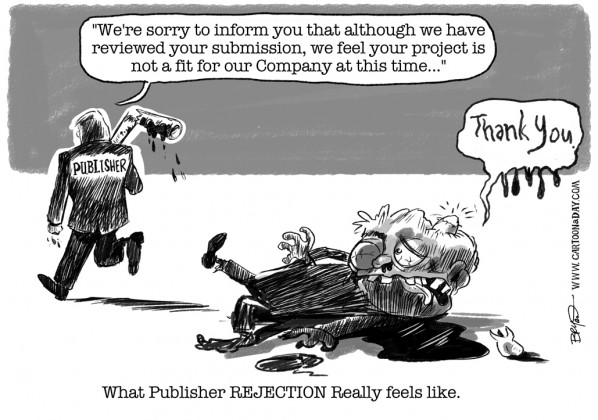Publisher Rejection Cartoon Writer 2012
Chances are pretty high that you either ARE a writer, have written a screenplay, short story, poem, novel, or know someone who fits that description. Then you may be able to relate to the rejection letter cartoon. Publishers receive unsolicited manuscripts by the hundreds every day (unsolicited means you send a synopsis , sample chapters, page and word count -etc, without being asked to). Solicited manuscripts get special treatment because the book publisher has been looking forward to your book, and that usually occurs after your first publishing, or some fancy verbal footwork by an AGENT.
So here’s a little publishing advice from a CARTOONISH who’s published a couple 100,000 word novels:
BEFORE you submit:
1. Join a writer /book club. You can find one nearly anywhere that meets once a week at a local coffee shop. You’ll bring multiple copies of your manuscript current chapter and distribute to each member (they will do likewise). The larger the group, the better the feedback but be warned: it’s also more homework. I dropped out of my book club when I was editing ( and I mean red ink conjugation, punctuation, tense issues) more than a dozen chapters a week that weren’t mine. Keep the group small, and you’ll have better results. Keep your samples each week small too. If you’ve written 50 pages, they’ll only skim it.
2.Listen to everything your peers say about your book, and almost totally ignore it. You can get into serious trouble with plot lines, character development, and simple shortsightedness if you try to please every reader all the time. Just try to please yourself.
3. FInd an editor. I can’t stress this enough. I self-edited my book and regret it. You’ll get tunnel vision, you’ll have way too many adjectives, and you’re write jokes only you know the punchline to. Find an English teacher who will work part-time for a few bucks. Find a college student who’s majoring in fiction (who won’t steal it). Or FIND AN AGENT. Having an Agent doesn’t mean they’ll edit it for you.
4. AGENTS. As stated above, an agent does not edit your book. An agent does not fill in plot holes or build characters. Agents do not usually design your book cover or take your dust jacket photo. You’re a writer (with a story and vision) and it’s up to you to bring that story to the page in a reasonably final way. AGENTS will either love it or hate it. Either way, if you’ve done your job presenting it, the Agent will SELL IT. Publishers have a couple in-boxes. Unsolicited (in the hundreds and usually read by college interns), and Solicited (direct submissions from proven and known Agents who have personally spoken to an editor). To whom would YOU rather submit to?
AFTER SUBMISSION:
Ah the mighty and thunderous REJECTION letter. You WILL receive them. If you’re actually TRYING to get your book published, you will receive MANY, so keep your chin up. Make a collage of the rejections. Make a sculpture out of them. Let the rejections motivate you to be relentless.
So get an Agent. Finding an agent is a lot like finding a publisher. Some writers will tell you it tougher getting an agent than getting a publisher through unsolicited channels. Some will tell you it helps to stand out in the submissions pile, and others disagree.
DO NOT print out your manuscript on red, orange, or some other gimmicky colored paper. DO NOT Single space your submission, or change the font size to make it look bigger. DO put your contact info in the corner of EVERY SINGLE page. DO INDENT every paragraph. DO SEND as much or as little as the submissions office asks for, EXACTLY. Every publisher seems to have different requirements. Check if they’ll take digital submissions.
As a freelance illustrator, I am called on OFTEN to illustrate your book, by you, the author, PRIOR to publishing. I DO NOT recommend spending your own cash to speculatively find an artist and collaborate on a cover idea for submission to a publisher. The PUBLISHER WILL CHANGE it. Some writers will say the publisher appreciates this, and that’s true ONLY if they Specify it. DON’T assume you know more about Point-Of-Sale marketing than someone who specializes in it.
IF IT’s a CHILDREN’s Book…a sample of the illustration STYLE you’re looking for will suffice, and I have had some success producing sample art for the manuscripts. It’s ultimately up to the publisher whether they use your artist or not, so don’t promise your artsy Nephew, Niece, Uncle or whatever, ANYTHING.
1. Write your book completely.
2 Find an editor.
3. Find an Agent.
4. Prepare submissions exactly.
5. Send.
6. Prepare for a lot of waiting and rejections.
7. Keep your spirits up.
8. Start your second book.
9. Keep your fingers crossed on those lonely, cold nights.
10. Throw a publishing party inviting all your friends when your first box of fresh-off-the-press-novels comes to you in the mail (not before).
More Cartoons Like This:
- 3D Book Sculpture-Visible Novel 3D Book Sculpture-Visible Novel As a break from Cartooning...
- Paper Book Vs Digital Book Showdown Cartoon Paper Book Vs Digital Book Showdown Cartoon A traditional...
- Scariest Halloween Costumes of 2011 Cartoon Scariest Halloween Costumes of 2011 Cartoon “Oh My, You...
- 3-D Book Art- Cutout Book Sculpture 3-D Book Art- Cutout Book Sculpture …And NOW for...
- Internet Bankrupts Borders Bookstores Internet Bankrupts Borders Super Bookstores Sad, but also true....



